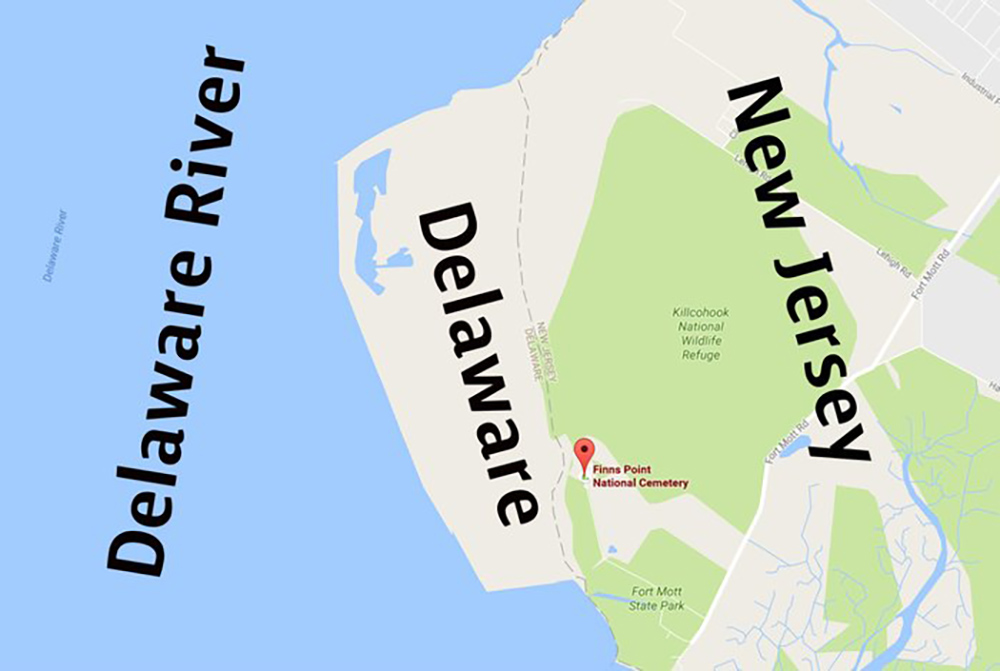By Sarah Fertsch
Staff Writer
To drive from New Jersey to Delaware, you don’t have to cross a bridge, or even take a ferry. Just go to Salem County, where seven miles south of the Delaware Memorial Bridge you’ll find Killcohook, an incorporated area of Delaware on the Jersey side of the river, that is if they’ll let you in.
Jump back in time to 100 years before the Revolutionary War. In 1681, William Penn and King Charles II of England signed a treaty to separate Delaware from Pennsylvania, which included modern-day South Jersey. The two men agreed to draw a 12-mile circle around the city of New Castle. Everything within the arc was Delaware’s, including the entire Delaware River over to the low-tide mark of the New Jersey shoreline.
Because of that document, Delaware owns around 26 miles of the Delaware River from the northern tip of what is now Artificial Island, Lower Alloways Creek, north to roughly around Logan Township in Gloucester County.
At that time, Killcohook was marshland, situated just barely above the waterline. The secluded area, which today is used by the Army Corps of Engineers as a dredge spoil disposal site, has emerged above the tides over the years.
Tim Rooney, a project manager with the Army Corps, said Killcohook acts more as a federal preserve than a portion of Delaware.
“We have put up gates to keep the public out so technically, New Jersey folks can’t just step into Delaware in\ Salem County,” he said of the 1,430-acre site. “But this isn’t like Area 51 or Fort Knox; it’s open wilderness.”
Locals have nicknamed Killcohook “The Baja,” after the northwestern deserted area of Mexico. The name means windswept wilderness, or a place absent from society.
Thomas James, a Pennsville resident, reports that kids ride dirt bikes and drink beer there because New Jersey authorities have no jurisdiction in Delaware and can’t intervene in their shenanigans. “Some people think that the Jersey Devil actually lives in Delaware, in Killcohook,” said James.
If a crime were committed in the contested land, Pennsville, the closest New Jersey town, would have no authority to act. Authorities from Delaware would have to drive miles and miles to intercept criminals or extinguish a fire.
Killcohook has become known as “New Jersey’s little oddity” and offers a lesson in American history and federalism. Delaware, already a small state, takes pride in the additional land “won in its own way” from New Jersey and used to support the nation as a whole. However, the spot has spawned controversy even in modern times.
In 2008 the petroleum goliath BP, was prevented from building a $700 million natural gas terminal along the Delaware River, technically in the state of Delaware. The state rejected BP’s proposed plans because it violated a law that limits industrial development along the coast.
The dispute made it all the way to the U.S. Supreme Court where Justice Ruth Bader Ginsburg wrote for the majority, preserving the sanctity of the 12-mile circle. BP hoped that New Jersey would gain authority over the region and give permission for them to build the plant, but the majority cemented Delaware’s jurisdiction over Killcohook permanently.
New Jersey residents have jokingly discussed sending the Battleship New Jersey down the Delaware River to secure the tiny piece of territory. When Jersey legislators brought up the topic, Delaware responded by threatening to call in the National Guard. No shots were fired.
Killcohook, which was a designated wildlife refuge before the Army Corps of Engineers took it over in 1998, has blossomed into a beautiful piece of land overflowing with foxes, goldfinches, deer, and unfortunately, mosquitoes. Eight-foot tall river grasses line the unpaved roadway and give the land a wild vibe.
Even if it technically doesn’t belong to New Jersey, Killcohook is still very special.]
Sarah Fertsch was born and raised in Egg Harbor Township, and holds a dual degree in public relations and political science. Prior to joining Shore Local full-time, she worked at a CSPAN affiliate, writing about Pennsylvania legislation. When she isn’t writing, Sarah enjoys painting, horseback riding, and Crossfit.






